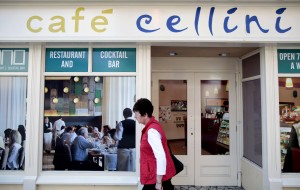Derelict Northern Ireland shops get facelift to charm G-8

A woman walks past a derelict shop, its windows covered in giant posters to make it look like a cafe, in Enniskillen, Northern Ireland, Thursday, June 6, 2013. Organizers of the G-8 summit of world leaders June 17-18 in Northern Ireland have spent weeks sprucing up the facades of businesses all around the County Fermanagh venue. Their use of window-sized posters to make them appear like thriving businesses with fully stocked shelves, has proved most eye-catching — indeed, eye-fooling. (AP Photo/Peter Morrison)
BELFAST, Northern Ireland—The Northern Ireland border village of Belcoo has never looked so good. And critics say that’s just the problem.
Organizers of the G-8 summit of world leaders June 17-18 in Northern Ireland have spent weeks sprucing up the facades of businesses all around the County Fermanagh venue. Their use of window-sized posters on two derelict Belcoo shops, to make them appear like thriving businesses with fully stocked shelves, has proved most eye-catching—indeed, eye-fooling.
While many in the border village of barely 500 residents and two pubs applaud the novel use of posters to give their home a cheerier look, some complain they’ve covered up the reality of economic hard times.
To passing motorists, the former Flanagan’s butcher’s shop in Belcoo looks packed to the rafters with fresh cuts of meat. Its locked door even has a poster on it, depicting an open door so convincing that would-be shoppers have nearly strolled into the wall. Across the road, a former pharmacy’s windows have been covered with images of shelves full of office supplies, books and computer software.
In reality Belcoo, which lies directly on the Republic of Ireland border and about 10 miles (15 kilometers) south of the luxury golf resort hosting the G-8 summit, has been hard hit by the staggering collapse of Ireland’s Celtic Tiger economy. Many who were previously employed in construction sites have struggled to find regular work since 2009. The area’s biggest employer, fallen billionaire Sean Quinn, has seen his cross-border business empire of insurance, building supplies and luxury hotels seized by an Irish state-owned bank as part of Ireland’s biggest bankruptcy fight in history.
Article continues after this advertisementElsewhere in Fermanagh, a typically rain-soaked lakeland renowned for its fishing and friendly banter, banners depicting the county’s historical sites and scenery have been deployed across the fronts of empty commercial buildings. The village of Fivemiletown has witnessed its own transformation of two vacant storefronts into an antiques shop and a delicatessen, complete with posterized bicycle propped outside the door.
Article continues after this advertisementPhil Flanagan, whose family shut down Belcoo’s butcher shop last year, said the G-8 spruce-up had brought welcome work to painters and plasterers, but he believes the lifelike veneers on abandoned shops are a deception too far. He said the reported 300,000 pounds ($500,000) used on pre-G-8 cosmetic work for Fermanagh would have been better spent on reviving a real local employer.
“Some people are putting out the idea that there’s no such a thing as a closed-down business in Fermanagh. It’s a huge lie and a false economy,” Flanagan said.
While images of the faux Flanagan’s shop have circulated around the Internet this week, the practice of adorning fake fronts on commercial eyesores has been a widespread practice in Britain and the United States for years.
Former New York Mayor Ed Koch pioneered the practice back in the early 1980s to conceal urban decay, and chambers of commerce in some northern English cities have been using the window posters since 2010.
The Northern Ireland capital, Belfast, first used the fake-shop posters last year along the main drag of Protestant east Belfast, where strips of family run small shops have been hard hit by recession and competition from modern shopping malls.
They all draw historical inspiration from the original eye trick of legend: the Potemkin villages of 18th-century Russia. According to disputed folklore, these large-scale paintings and facades of villages were deployed along the banks of the River Dneiper to fool Russia’s ruler, Catherine the Great, into believing that her war-battered region of Crimea was thriving.—Shawn Pogatchnik